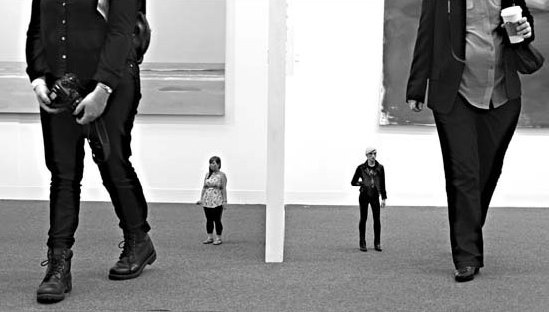New York's art and tech worlds slow to mix
Updated: 2013-04-14 08:07
By Alice Gregory(The New York Times)
|
|||||||
|
The Armory Show, a New York arts fair, left some high-tech personalities bemused. Tomoaki Suzuki's tiny sculptures. Nat Castaneda / Associated Press |
Technology innovators and the venture capitalists who back them are not collecting much art, according to people in both the tech and art worlds. And, for the latter, this is a big problem.
"It's hard to get those guys' attention," said Thea Westreich, 70, a veteran art adviser in New York. "I think they will eventually collect, and collect very heavily and be a part of the community. But I think that's going to be a hard wall to go through."
Rex Sorgatz, 40, a digital consultant for Web businesses and magazines, is among the few in Silicon Alley, the high-tech area in New York, who socialize with the art clique. Mr. Sorgatz said that if he invited any of his tech friends to the Guggenheim Museum in New York, most would turn him down.
"I've been a bit disappointed by the disconnect between New York City's art world and technology space," he wrote in an e-mail.
There are all sorts of plausible explanations: the tech industry is relatively new (especially in New York); its members are young, busy and most did not plod through four years' worth of liberal arts studies. But as many in the art world point out, there is no reason new-media moguls cannot get a remedial art education now.
Sima Familant, a New York art adviser, said she thought the tech industry had almost an obligation to become more engaged.
"If these are our next Rockefellers, Carnegies, Fricks, whatever you want to say in terms of our wealthy American elite, then why aren't they supporting culture?" she asked.
Ms. Familant, 40, said she worried for the future of privately financed arts establishments.
But there are signs that the hesitation is evolving. At the Armory Show, an international art fair held in New York in March, a group of tech-world transplants were browsing. John Resig, the JavaScript programmer; Georg Petschnigg, a founder and the chief executive of FiftyThree; and Serkan Piantino, a Facebook engineer, all made the rounds.
"There's so much more art in New York," said Mr. Petschnigg, 35, who used to live in Seattle and work for Microsoft. "To really understand it, you need friends."
Mr. Resig, 28, found the Armory Show "a little harsh." In tech, Mr. Resig said, there tends to be "a culture of openness," with people taking pride in sharing their work and allowing others to use it.
"This seemed sort of the, like, opposite atmosphere: exclusive, hidden," he said.
Jonah Peretti, 39, a founder of BuzzFeed and The Huffington Post, said even if you have money, "it doesn't mean you're part of the club."
To those used to start-up culture, with its utopian transparency and meritocratic ideals, the art world's barriers to entry are discouraging. Parties are exclusive. Works are not always sold to those with the most money. Images are often not online.
Mo Koyfman, a venture capitalist at Spark Capital, which has provided funding for companies including Twitter and Foursquare, said there is good reason why technology entrepreneurs struggle with the art world.
"For technologists, it's all about leveling the playing field, and the art world is a very structured, hierarchical system," he said. "There is a conflict there."
Mr. Koyfman, 35, who collects emerging artists who show in galleries on the Lower East Side of New York, said that he thought this tension is less pronounced in New York City than it is in Silicon Valley in California, citing a handful of local start-ups operating at the intersection of art and technology: Tumblr, Kickstarter, Etsy.
"As there are more and more Internet successes here in New York, I would expect these people to have more of a fondness for and interest in collecting art, because it's New York," Mr. Koyfman said. "That's why you live here. If you didn't want to be exposed to the arts, go live in the Valley."
But geographical proximity does not do much to mitigate the prevailing chill between the two spheres, many in each say.
"Walking into a gallery is a very daunting experience, even if you're Mark Zuckerberg," said Mike Brown, a founder of AOL Ventures.
"A lot of guys who are generally introverts, who are building technology all day, they're stonewalled once and they say, 'Why do I even bother?'" he said.
Mr. Brown's art adviser, Sarah Jane Bruce, 35, agreed. "There's a natural barrier to the art world," Ms. Bruce said. "It's insular and closed. Prices aren't published, you have to go up to someone and ask. It can be a very intimidating experience."
The New York Times
(China Daily 04/14/2013 page12)
